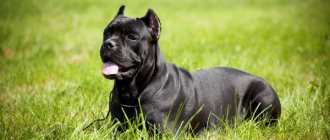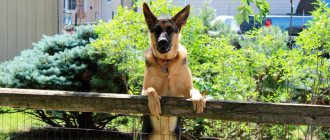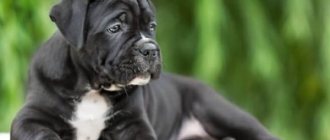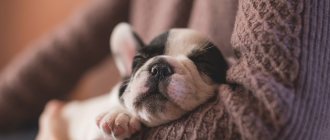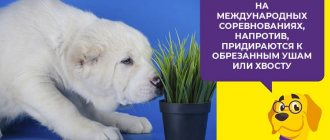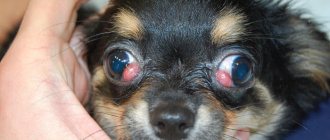Historical reference
The Cane Corso dog breed is undeniably the heir to the ancient Molossians, to be more precise, the ancient Tibetan Great Danes.
Modern Tibetan Mastiffs (Mastiffs) are a breed that has experienced “reincarnation” more than once, but their appearance even today makes people shiver with goosebumps. The first Tibetan Dogo appeared on the Eurasian mainland 1000 years BC, or so the story goes. New breeds of dogs have been developed over the centuries to suit the needs of specific territories. The descendants of the Molossians who came to the Roman Empire were also used for their intended purpose - arena battles, military campaigns, and territory protection. Mentions of giants called Corso are found in hunting and baiting chronicles dating back to 1400–1500.
It is ethical to count the official history of the breed from the times of the prosperity of the Roman Empire. It is this time period that is replete with historical monuments depicting the early Cane Corso in hunting, arenas and fighting. The development of these powerful dogs is continuously intertwined with the history of Italy.
The Roman Empire fell shortly before the fifth hundred years of our era and a feudal system reigned in Italy. This stage should be considered as a separate step in the formation of the breed. The export of dogs atypical for Italy, for example, Celtic Greyhounds, led to changes and the creation of new progenitors of the breed.
With the new regime, dogs began to be used in a new position - guarding farms in the off-season. After the harvest, the land was left under the responsibility of one person and several Cane Corsos. It should be noted that the breed was used for quite a long time as a cattle driver, which also limited contact with the outside world. The echoes of such “professions” were unshakable loyalty to one person - the owner.
Appearance
The description of the breed constantly echoes the gladiatorial past of the Cane Corso. A rectangular silhouette, powerful but lean muscles, wide and strong bones, a voluminous head and the elegance of a warrior emphasizing all these advantages. Lightning-fast reactions and readiness for action demonstrate their protective characteristics in representatives of the breed. The size of the breed is estimated as large or medium. The height and weight of the Cane Corso are predetermined by the standard and vary within strict limits:
- Males: 62–70 cm; 45–50 kg.
- Females: 58–66 cm; 40–45 kg.
Breed standard
- The head is large with a flat and wide forehead. The dividing furrow is moderately expressed, but the skin is not gathered into folds, like the Mastiff. The skull is spacious, with pronounced cheekbones and eye sockets. The forehead is rounded in the anterior lobe, flat in the middle and sloping in the area of the transition to the occipital protuberance. The transition from forehead to muzzle is well defined. The lines of the back of the nose and forehead are parallel. The muzzle is deep and square when viewed from above and from the side, half as long as the skull. The end of the muzzle is U-shaped. The lips are thick, close-fitting, rounded, drooping slightly. The teeth are large, tightly set, in full set. The bite is undershot with a gap of no more than 0.5 cm. A pincer-shaped bite is also allowed in Cane Corso, but this position of the jaws can lead to early damage to the teeth and a weakening of the grip.
- The nose is large and does not protrude beyond the back of the nose and the line of the lower jaw, the nostrils are rounded and open. The pigmentation of the nose is predominantly black, but if there is a mask in the design, then the lobe can be colored to match the coat.
- The eyes are of medium size, oval, set wide and high. The look is attentive, intelligent, lively, controlling. The Cane Corso has slightly protruding eyes (but not bulging or too round). The color of the iris is brown, as dark as possible, but should be in harmony with the color of the coat.
- Ears - lowered forward, triangular, thick with a rounded tip. According to the new standard, which came into force in 2021, ear cropping of Cane Corso is prohibited. However, previously registered dogs can be docked without losing points.
- The body has a stocky, stable structure, but a rectangular format. The length of the muscular, oval neck is equal to the width of the head. The neck extends into pronounced withers and a strong, broad back. The line of the back, falling from the shoulder girdle to the convex loin and sloping croup. The chest is a classic Molosser oval shape, wide, descending to the elbow line.
- The limbs are strong, set moderately wide, under the body, with pronounced muscles. The front legs are set at a slight angle, the shoulders are powerful and naturally inclined, the pasterns are slightly inclined in relation to the ground, the joints are strong and flexible. The hind legs are more massively muscled, the hips are convex, the knee joints are strong, the hocks are moderately sloping. The hands are collected, compressed, the toes of the hind paws are longer than the front ones. The claws are well curved and dark.
- The tail is not docked, strong, thick, set high, as straight as possible. Carried high, at the level of the spine, or low (at rest).
READ Mating of cats - what the owner needs to know
Coat type and color
The Cane Corso is a short-haired breed, but not without undercoat. The guard hair is quite hard and tight-fitting; in a healthy, well-developed dog, the coat has a sheen. Speaking about the colors of the breed, it is worth understanding that there is an unspoken gradation of Cane Corso. Colors are closely related to the characteristics of the exterior, and it, in turn, is divided into three types: Doji, Mastino, Staff Terrier. The standard specifies the following criteria:
- Color – black, black with steel or blue, dark and light gray, dark and light red, fawn.
- Pattern – brindle or without pattern.
- Mask - for red and brindle dogs.
- White markings - a tie or spot on the chest, a mark on the bridge of the nose, small spots or toes on the paws.
Popular colors include black and brindle with a varied palette of basic coat tones. Disqualifying colors are pure white (or white spots on the body), cream, tan, deep brown.
Put it right
It is important that the specialist places the ears correctly and that they fit the pet. You should also know that after surgery you will have to take care of your dog's ears for some time. In order for such ears to stand beautifully, the owner must take care and glue the cartilages with adhesive tape so that they stand beautifully. After all, this breed's ears are trimmed in a triangle.
Choose an experienced and trusted veterinarian so that he knows how to position the Cane Corso's ears correctly.
Remember that the puppy must be absolutely healthy before docking its ears and tail! He should not have fleas or worms. Vaccinations can be done during this period. For about twelve hours before surgery, do not let your puppy eat and keep an eye on him. Let the puppy be calm before anesthesia; do not play with him. Prepare in advance the medications you may need: brilliant green, antiseptics, bactericidal powders, hydrogen peroxide, sterile wipes, paper-based adhesive plaster only, a postoperative collar and whatever the veterinarian tells you to look after cropped ears.
Character and training
Were you fascinated by the exhibition photos of the powerful Cane Corso and this became the determining factor for choosing the breed? Take your time! Cane Corso puppies are adorable, but already have their own understanding of the world and a rather independent disposition. It is worth understanding that the balance prescribed by the characteristics of the breed is only 50% a genetic factor. In fact, whether a grown-up child will become a full-fledged member of society or a threat depends on his upbringing.
The character of the Cane Corso can be called universal, although the highly developed instinct of territoriality always takes its toll. The four-legged dog passionately loves his family, shows a protective attitude towards children and respects the boundaries of the territory entrusted to him. A stranger who comes to the Cane Corso's house is under constant control and evaluation, but the further actions of the tailed guardian depend on his socialization.
Some owners believe that a guard dog puppy should be isolated from society. By limiting the baby's contact with the outside world, the owner hopes that the dog will clearly understand where it is and where it is a stranger. A huge mistake! The Cane Corso will protect his family and home until his last breath even without your help. Reclusion will only lead to outbursts of aggression directed at guests who come for coffee.
Immediately after receiving basic vaccination, the baby should receive the maximum portion of communication with relatives and strangers. Alertness should be encouraged, sharp aggression should be suppressed. Be prepared for the fact that the transitional age of the Cane Corso will last up to 2-3 years, which means training too. We have gradually come to the main disadvantage of the breed, at least that is what is “commonly believed” - difficulties with training.
The breed is distinguished by its attentiveness and good memory, that is, theoretically, “it takes commands on the fly,” but it’s not like that! Cane Corso does not like “show off”, monotony, or useless actions. Your task is to make the training interesting, dilute it with games or joint physical exercises. The main thing is not to push yourself, not to humiliate, and not even to allow yourself to be disappointed in your heart. Your four-legged companion perfectly “reads” your emotions and is not inclined to prove his superiority - “Do they think I’m stupid? Well, so be it."
The need for a Cane Corso to undergo a ZKS (protective guard duty) course is quite controversial. According to the subjective opinion of famous trainers, training is justified if your pet has a harsh and almost uncontrollable temperament. With the help of the ZKS, the dog is taught to use its skills. Otherwise, the monotony of classes can have the opposite effect.
READ Which cats heal people and how to choose a furry healer
Video “Cane Corso after ear cropping”
From this video you will learn about how a dog behaves after ear cupping.
Related article: How to choose and name a Cane Corso puppy
Recommended Posts
Everything about the Cane Corso or Italian Mastiff breed, pros and cons, photos
The most common and rare Cane Corso colors
Standard height and weight of the Cane Corso breed by month
Cropping and setting of ears in toy terriers
How much does ear cropping for a miniature pinscher cost and how does it work?
What can and cannot be fed to a Cane Corso dog?
Maintenance and care
Since the Cane Corso is considered a medium to large dog, many potential owners have doubts about the pet's living conditions. To begin with, it is worth understanding that your future family member has short hair and a rather poor undercoat, so keeping a Cane Corso outside in winter is not even discussed.
Walking in the cold season and playing in the snow are welcome, but after that, the dog should rest in the warmth. Whether to buy a dog for an apartment is a controversial question and most likely the answer is positive, of course, if the square footage of the home allows it. The next question that worries many is the “dog smell” in the house. Cane Corso is a non-smelling breed, but this condition is only true if the standards of maintenance and nutrition are observed.
It is worth noting that walking with a Cane Corso involves serious physical activity, which will also affect the owner. Don’t be lazy and work with your ward as much as necessary. Otherwise, the pet will gain excess weight, and with its predisposition to joint pathologies, this is too big a risk.
Since the breed requires long walks intermittently, in frosty and slushy weather you will need clothing for your Cane Corso. In addition to the obvious advantage of maintaining a stable body temperature, you will receive another benefit - preventing wool contamination. Naturally, the dog needs to be bathed, but hygiene procedures should not be daily.
Once every 2-3 weeks it is necessary to inspect the claws of the ward and, if necessary, trim them. A special guillotine nail clipper is used to trim claws. Considering the general dislike of dogs for this procedure, the first haircut should be entrusted to a veterinarian. At an older age, when the four-legged dog masters the command “Give me your paw” and understands that you do not want to harm him, trimming his claws will become a common procedure.
In conditions of proper maintenance and proper feeding, dog care is reduced to a minimum. Short hair should be brushed with a soft brush as needed. If you make it a habit to brush your dog every day, shedding will go unnoticed. The eyes are wiped with a damp cotton pad several times a week, but examined every day.
Caring for the ears depends on their length, or more precisely, whether the dog is cropped or not. The natural length of the ear cartilage covers the concha, which leads to more active plaque formation. Daily inspection will help prevent excessive contamination, and cleaning once every 1-2 weeks will minimize the risk of inflammatory processes.
Cropped ears are a little more difficult to care for. The main difficulties are related to the inability to position the ears correctly. During the period of teeth change, the ears of the overwhelming majority of puppies fall off, and given their length, there is practically no chance of raising them on their own. However, you shouldn’t be scared; any breeder that respects himself and his dogs will be happy to teach you how to glue a puppy’s cropped ears. If the procedure seems too complicated for you, you can always contact your veterinarian.
Dental care is relevant and important, even if your pet does not participate in breeding examinations. An undershot, and even more so a direct bite, can provoke incomplete closure of the chewing teeth. In turn, teeth that are not involved in chewing quickly deteriorate. Dental health also depends on nutrition. A dog fed dry food or soft cartilage will clear plaque naturally. In addition, your pet should be regularly taken to the veterinarian and have its teeth cleaned.
READ Chartreux breed description, character traits, care and maintenance
Otherwise, caring for the Cane Corso is no different from other breeds. The puppy will need a lot of toys, especially during the teething period. Be sure to teach your child how to properly walk on a leash and wear a muzzle. Do not forget that the safety of others and your pet depends on its upbringing, physical and mental health.
Simple and obedient
Caring for and raising a pet of this particular breed is simple. Sufficiently monitors the hygiene and cleanliness of the wool. It is better to keep such dogs for those who live in a private house or country house, they love to run, they need freedom. Such a dog is not kept on a leash, and in winter the pet does not need to spend the winter outside, it has thin fur. It's easy to train a dog, it's smart and obedient!
If you have purchased a Cane Corso puppy, you should take this seriously. It is necessary to determine for him a place where he will feel comfortable and warm, safe. Monitor his diet and health, get all the necessary vaccinations and procedures, and also think about the question of how to install the ears and cropping the puppy’s ears. The ears of a dog of this breed may not be cropped. They are hanging, wide at the base, and set high. However, more often they are stopped, usually in a triangular shape. This gives the dog a more well-groomed and menacing appearance, due to the structure of its muzzle and skull.
By the way, many owners of dogs of this breed simply do not imagine their ears drooping, this is from the experience and practice of experienced dog breeders, and even more so this applies to the dog’s tail. In all of nature there are almost no dogs with drooping ears; remember their ancestors - wolves. This is not a whim at all, but simply a vital necessity for your pet. Nowadays, such operations are simple, but very important, because ears are cut once and for the rest of the dog’s life!
Many breeders of Cane Corso dogs believe that undocked ears on such dogs look ridiculous and funny, amusing, the animal loses all its strict and majestic, noble appearance. Many people don’t even buy puppies with uncropped ears; they may remain unsold. At Italian dog shows, dogs with cropped ears have priority.
Health
The lifespan of the Cane Corso is 10–11 years, taking into account the size and artificial restoration of the breed, this is a good indicator. Breeders all over the world are waging an unequal struggle with genetics, trying to minimize the risk of typical ailments of four-legged giants. Even the best quality care does not exclude the occurrence of acquired pathologies, however, it is worth knowing everything about the inclinations of your new pet. So, common Cane Corso diseases are:
- Dislocations and displacements of joints, strains of tendons and muscles are common injuries after walks with active games. A puppy under 18 months of age should be especially taken care of, avoiding excessive stress on the joints, long runs or jumping from great heights.
- Hip dysplasia – for the Cane Corso, the disease is both hereditary and acquired. Puppies sold from nurseries have documented evidence of the absence of dysplasia. The disease affects the hip and, less commonly, elbow joints and leads to deformation of the joints. The dog experiences severe pain when trying to rise from a lying position, walking, and especially running. There is no effective outpatient treatment and the use of medication is only justified at an early stage. In an acute condition, the dog is operated on.
- Eversion and inversion of the eyelid are a violation of the structure of the eyelid (most often the lower one). When deformed, constant irritation of the mucous membrane of the eye occurs, which is guaranteed to lead to redness and inflammation. In advanced cases, a small problem can provoke retinal degeneration and, as a result, vision loss. Both ailments can be treated with a simple operation.
- Cherry eye (prolapse of the gland of the third eyelid) - due to a violation of the elasticity of the connecting fibers, the gland of the third eyelid is deformed, extends beyond the boundaries of its membrane and becomes inflamed. The pathology is expressed by redness of the third eyelid, most often does not bring pain or particular discomfort to the animal. Prolapse is treated by surgically reducing the gland.
- Volvulus of the stomach or intestines is a pathology with a 100% fatal outcome in the absence of urgent surgical intervention. Volvulus occurs against the background of physical exertion and is an overlap of a fragment of an organ. The wrapped area of the intestine or stomach is deprived of blood circulation, which leads to the rapid development of necrosis and sepsis.
- An allergy is a reaction of the immune system to substances from the environment, most often food or grass pollen. With the right nutrition and appropriate care, a dog can lead a full life. It is worth noting that Cane Corso are prone to severe allergic reactions, including swelling of the larynx.
- Stroke - in simple terms, the pathology is accompanied by a disruption of the blood supply to the brain. There can be hundreds of reasons, from a blood clot and injury, to fear or stress. The consequences are also unpredictable; a micro-stroke may not be noticeable; in a more severe case, an attack can lead to blindness, paralysis, convulsions and death.
- Neoplasm (tumor) of the mammary glands - the risk is more relevant to females, since degeneration of mammary gland cells in males accounts for less than 1% of all recorded cases. For a Cane Corso, a mammary tumor has a 50% chance of developing into cancer. If histology shows the tumor to be benign, the disease is eliminated surgically.
- Epilepsy is a neurological pathology that is expressed by unpredictable attacks of trembling and convulsions, up to and including falling into a coma and death. Unfortunately, there is no effective treatment for this disorder; a dog experiencing seizures is given supportive care.
Description of the ear cropping procedure
Breeds of fighting and hunting dogs have had their ears artificially shortened for thousands of years, so information about the shape and cut line along which docking occurs in certain breeds has been enshrined in the rules of the standard from century to century.
Surgical cutting of the ears occurs at an appropriate angle, and a certain position of the ears is also regulated. Caucasian Shepherd dogs have a significant portion of their ears removed; in pit bulls it is almost two-thirds.
The edge of the cut part is sometimes straight, but in some cases it is S-shaped; in Pinschers and Great Danes it is customary to give the ear a pointed shape. According to the rules and certain standards, the resulting ear length for a Staffordshire Terrier must be equal to the distance from the edge of the eye to the base of the auricle. And the cut line should not be curly, as when cropping the ears of a Doberman , but be a straight line.
The operation itself may not last long, measured in time periods of no more than half an hour, but due to circumstances it can be extended up to one and a half hours. It is performed for puppies under local anesthesia, but adult dogs require general anesthesia.
The owner is required to hold the pet on the operating table, ensuring that it is fixed in the desired position for the veterinarian performing the docking. In this case, the animal holds on to its front and hind legs.
The owners present are also required to ensure that the dog does not move its body, which is usually secured, moreover, with straps. For safety reasons, in order to avoid bites, it is best to put a muzzle on the dog, but for obedient and flexible dogs, simple fixation of the jaws is allowed.
The hair in the ear area is carefully trimmed, and the skin in the area of the shells is treated with an antiseptic solution immediately before the operation. Among the carefully sterilized instruments intended for the procedure are surgical scissors, as well as a set of clamps that are applied to the ears during the operation.
This also includes a pattern for ear cropping , which helps to maintain the established accuracy of the lines. Anesthesia is administered before the first incision is made.
Next, if everything is over, everything went well and there is no bleeding, after 8 minutes the clamps are removed, the edges of the wound are sutured and treated with antibacterial agents. Recently, cyacrine glue is often used instead of sutures.
